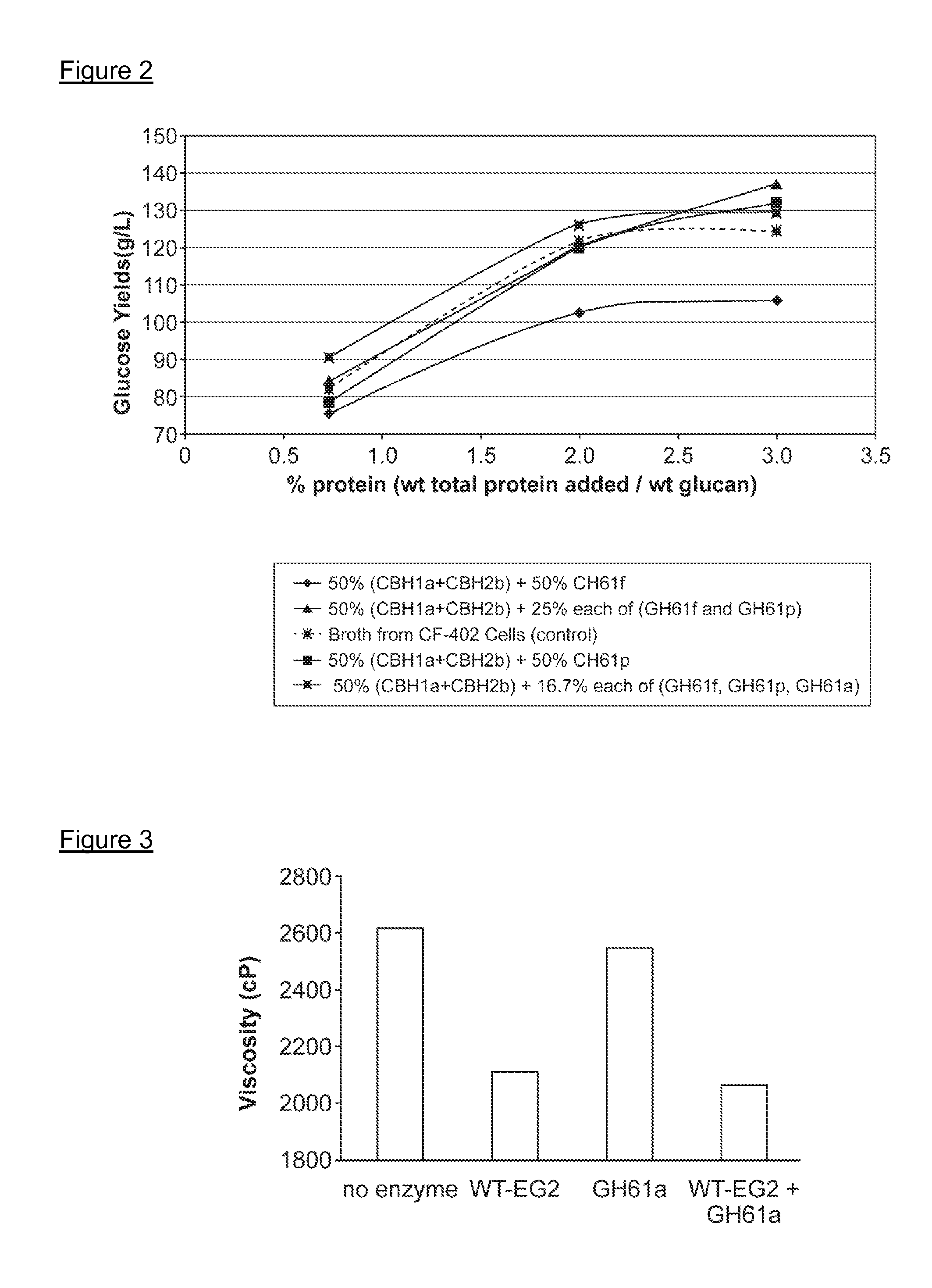Use of glycoside hydrolase 61 family proteins in processing of cellulose
a glycoside hydrolase and cellulose technology, applied in the field of glycoside hydrolases, can solve the problems of difficult conversion efficiency of cellulosic biomass to fermentable sugars, and achieve the effect of increasing product yield and product yield
- Summary
- Abstract
- Description
- Claims
- Application Information
AI Technical Summary
Benefits of technology
Problems solved by technology
Method used
Image
Examples
example 1
Identification of GH61 Proteins in M. thermophila
[0275]The genomic sequence of a M. thermophila wild-type fungal strain was obtained. The entire genome was analyzed to identify and evaluate protein coding regions. Twenty four proteins endogenous to the M. thermophila strain were selected based on factors including the presence of glycohydrolase family 61 (GH61) sequence motifs (Pfam domains). Pfam domains were identified using the software algorithm “PFAM v.24”, developed by the Wellcome Trust Sanger Institute (Henrissat et al., 1995, Proc Natl Acad Sci USA 92:7090-94).
[0276]TABLE 1 provides the sequence of a GH61 pre-protein (SEQ ID NO:1) and the predicted secreted (mature) form (SEQ ID NO:2). The mature protein was designated “GH61a”. TABLE 2 provides the sequences of other GH61 pre-proteins, with the predicted native signal peptide underlined. Two of the proteins in TABLE 2 are not predicted to have signal peptides.
[0277]Corresponding polynucleotide sequence numbering and domain...
example 2
Recombinant Expression of GH61 Proteins
[0281]Amongst the GH61 proteins identified in Example 1, certain exemplars were selected for expression based on predicted structural and functional aspects, such as whether a protein would be secreted from the cell, and its domain structure.
[0282]The six GH61 proteins listed in the following table each were cloned into an expression vector under the control of a CHI promoter (constitutive to the target cell) and transformed into a M. thermophila strain designated “CF-405” that has been adapted so as to be deficient in production of endogenous cellulases.
[0283]
TABLE 4Recombinantly expressed GH61 proteinsLaboratoryProteindesignationSEQ ID NOGH61a2GH61o6GH61v13GH61x15GH61b16GH61e19, 30
[0284]Transformed cells expressing the recombinant GH61 protein were selected and seed cultures were prepared. The progeny cells were cultured for 5 days, and broth containing the secreted GH61 protein was collected (“GH61 broth”).
example 3
Cellulase-Enhancing Activity of GH61 Protein
[0285]Broth from cells expressing the recombinant GH61 protein comprising SEQ ID NO:2 was collected (Example 2), and the level of recombinant GH61 was quantitated by SDS-PAGE. Cellulase assays were conducted to determine whether addition of the GH61 protein enhanced hydrolysis of cellulosic material by cellulase enzymes.
[0286]Culture broth was collected from a culture of an M. thermophila strain designated “CF-402” that overexpresses β-glucosidase. Cellulose digestion assays were carried out using the broth with or without added GH61. Reactions were run in Costar 96 deep well plates in a total reaction volume of about 80 microliters. The reactions were run at 55° C. using as the cellulose-containing substrate preparations of wheat straw that had been pretreated under acid conditions (hereinafter referred to as “pretreated wheat straw”). 8.1 mg broth protein per gram substrate (0.81%) was added to each sample. In addition, samples had 0 (co...
PUM
| Property | Measurement | Unit |
|---|---|---|
| total weight | aaaaa | aaaaa |
| concentration | aaaaa | aaaaa |
| pH | aaaaa | aaaaa |
Abstract
Description
Claims
Application Information
 Login to View More
Login to View More - R&D
- Intellectual Property
- Life Sciences
- Materials
- Tech Scout
- Unparalleled Data Quality
- Higher Quality Content
- 60% Fewer Hallucinations
Browse by: Latest US Patents, China's latest patents, Technical Efficacy Thesaurus, Application Domain, Technology Topic, Popular Technical Reports.
© 2025 PatSnap. All rights reserved.Legal|Privacy policy|Modern Slavery Act Transparency Statement|Sitemap|About US| Contact US: help@patsnap.com



